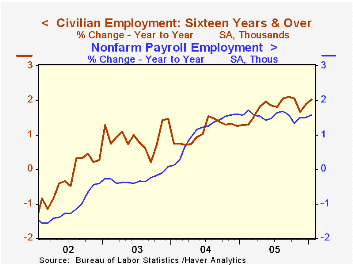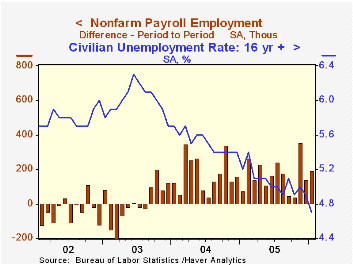 Global| Feb 03 2006
Global| Feb 03 2006U.S. Payrolls Just Below Expectations, Jobless Rate Lowest Since 2001
by:Tom Moeller
|in:Economy in Brief
Summary
In January, non-farm payrolls rose 193,000 following a December increase revised to 140,000 from the 108,000 reported last month. In addition, the November increase was revised up further 354,000 from last month's reported 305,000 [...]

In January, non-farm payrolls rose 193,000 following a December increase revised to 140,000 from the 108,000 reported last month. In addition, the November increase was revised up further 354,000 from last month's reported 305,000 gain and from 215,000 reported initially. Consensus expectations had been for a 250,000 January increase.
Benchmark revisions of the establishment survey data extended back to 2001. For 2005, the average monthly increase in payrolls was revised down to 165,000 from 179,300, but the average gain during 2004 was revised up to 175,000 from 123,000.
From the household survey the unemployment rate fell to the lowest level since July 2001. At 4.7%, the rate reflected a 295,000 (2.0% y/y) rise in employment and a 39,000 (1.5% y/y) decline in the labor force. A 4.9% unemployment rate had been the Consensus expectation for January.
Factory sector payrolls increased modestly following a downwardly revised December decline and the average gain in factory payrolls during the last three months of 2005 was revised slightly lower to 9,000. Nevertheless, the breadth of gain in factory payrolls rose to 52.4%, its best since July 2004.
Warm weather helped lift construction employment in January by 46,000 (4.8% y/y) following an upwardly revised 5,000 increase during December.
Private service producing payrolls rose the same 136,000 (1.8% y/y) in January as during an upwardly revised December despite a 1,500 decline in retail employment (+1.0% y/y). That decline was offset by a 21,000 (1.9% y/y) gain in finance and a 24,000 (3.1% y/y) increase in professional & business services. Education & health services jobs posted a 39,000 (2.1% y/y) increase while jobs in leisure & hospitality rose 26,000 (2.0% y/y).
Government sector employment fell 1,000 (+0.7% y/y) for the third decline in the last four months. Federal hiring fell 5,000 (-0.5% y/y) and state & local jobs increased 4,000 (0.9% y/y).
Average hourly earnings again were a bit stronger than expected, rising 0.4%. Factory sector earnings rose 0.2% (2.2% y/y) and private service producing wages rose 0.4% (3.5% y/y).
2006: A Year of Transition at the Federal Reserve from the Federal Reserve Bank of San Francisco can be found here.
| Employment | Jan | Dec | Y/Y | 2005 | 2004 | 2003 |
|---|---|---|---|---|---|---|
| Payroll Employment | 193,000 | 140,000 | 1.6% | 1.6% | 1.1% | -0.3% |
| Manufacturing | 7,000 | -1,000 | -0.3% | -0.6% | -1.3% | -4.9% |
| Average Weekly Hours | 33.8 | 33.8 | 33.7 (Jan '05) | 33.8 | 33.7 | 33.7 |
| Average Hourly Earnings | 0.4% | 0.4% | 3.3% | 2.8% | 2.1% | 2.7% |
| Unemployment Rate | 4.7% | 4.9% | 5.2% (Jan '05) | 5.1% | 5.5% | 6.0% |
Tom Moeller
AuthorMore in Author Profile »Prior to joining Haver Analytics in 2000, Mr. Moeller worked as the Economist at Chancellor Capital Management from 1985 to 1999. There, he developed comprehensive economic forecasts and interpreted economic data for equity and fixed income portfolio managers. Also at Chancellor, Mr. Moeller worked as an equity analyst and was responsible for researching and rating companies in the economically sensitive automobile and housing industries for investment in Chancellor’s equity portfolio. Prior to joining Chancellor, Mr. Moeller was an Economist at Citibank from 1979 to 1984. He also analyzed pricing behavior in the metals industry for the Council on Wage and Price Stability in Washington, D.C. In 1999, Mr. Moeller received the award for most accurate forecast from the Forecasters' Club of New York. From 1990 to 1992 he was President of the New York Association for Business Economists. Mr. Moeller earned an M.B.A. in Finance from Fordham University, where he graduated in 1987. He holds a Bachelor of Arts in Economics from George Washington University.






